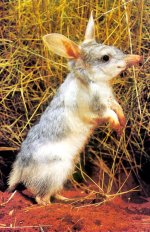 The Greater Bilby (Macrotis lagotis) is a marsupial, wearing its pouch backward to prevent any dirt coming in while digging. The other species in the genus Macrotis, the Lesser Bilby is extinct since the 1950s, because of fur trapping and the introduction of foxes and competition with introduced rabbits. The Greater Bilby is a nocturnal animal which live under the ground in burrows. Its diet consists of insects and their larvae which they search by digging small holes about 10 centimeters deep. They do not need to drink water as they get that from their food. Their numbers greatly declined because of the same reasons as the extinction of the Lesser Bilby. Bilbies have a long muzzle, characteristic to bandicoots and very long ears. There have been succesful reintroduction programs of the Bilby in Western and Southern Australia once rabbits, cats, and foxes are removed.
The Greater Bilby (Macrotis lagotis) is a marsupial, wearing its pouch backward to prevent any dirt coming in while digging. The other species in the genus Macrotis, the Lesser Bilby is extinct since the 1950s, because of fur trapping and the introduction of foxes and competition with introduced rabbits. The Greater Bilby is a nocturnal animal which live under the ground in burrows. Its diet consists of insects and their larvae which they search by digging small holes about 10 centimeters deep. They do not need to drink water as they get that from their food. Their numbers greatly declined because of the same reasons as the extinction of the Lesser Bilby. Bilbies have a long muzzle, characteristic to bandicoots and very long ears. There have been succesful reintroduction programs of the Bilby in Western and Southern Australia once rabbits, cats, and foxes are removed. Links
Queensland government Environmental Protection Agency - Bilby
Keywords: nocturnal
The Bilby, dalgyte, greater bilby, greater rabbit-eared bandicoot is listed as Vulnerable (VU), considered to be facing a high risk of extinction in the wild, on the IUCN Red List of Threatened Species
Countries
AustraliaBilby or greater bilby habitats
Desert, Forest, Grassland, Hot Desert, Shrubland, Subtropical / Tropical Dry forest, Subtropical / Tropical Dry Grassland and Subtropical / Tropical Dry ShrublandSome facts about the
Rabbit-bandicoot or bilby
Adult weight : 1.3 kg (2.86 lbs)
Maximum longevity : 10 years
Female maturity :150 days
Gestation : 17 days
Weaning : 110 days
Litter size : 2
Interval between litters : 175 days
Basal metabolic rate : 2 W
Body mass : 1.246 kg (2.7412 lbs)
Temperature : 34.85 °C (94.73 °F)

Custom Search